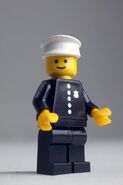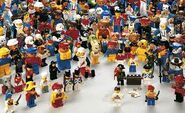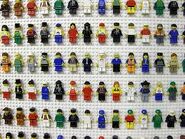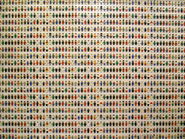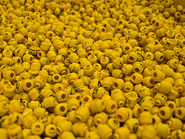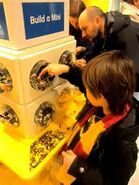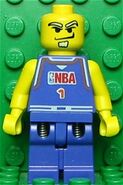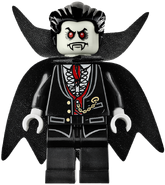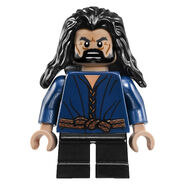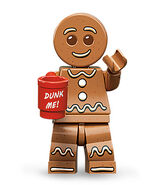König Skales (talk | contribs) No edit summary Tag: Visual edit |
|||
| (46 intermediate revisions by 16 users not shown) | |||
| Line 1: | Line 1: | ||
<!--Please DO NOT add random images of Minifigures to this article. Thank you.--> |
<!--Please DO NOT add random images of Minifigures to this article. Thank you.--> |
||
{{Rating|2}} |
{{Rating|2}} |
||
| − | {{OtherPage|[[LEGO]] figure|the theme|[[Minifigures (theme)|Minifigures]]}} |
+ | {{OtherPage|the [[LEGO]] figure|the theme|[[Minifigures (theme)|Minifigures]]}} |
{{Figure |
{{Figure |
||
|Name = |
|Name = |
||
| Line 10: | Line 10: | ||
}} |
}} |
||
| − | '''Minifigures''', commonly referred to as a "minifig", or simply just "fig", are small plastic figures just over 1 1/2 inches (4 cm), or four bricks tall. They connect to |
+ | '''Minifigures''', commonly referred to as a "minifig", or simply just "fig", are small plastic figures just over 1 1/2 inches (4 cm), or four bricks tall. They connect to LEGO System Bricks, and usually consist of 9-10 parts. The minifigure was designed by LEGO model builder [[Jens Nygaard Knudsen]], along with other early minifigure designs. The modern minifigure was patented with the U.S. Patent office on Dec. 18, 1979, with Knudsen and [[Godtfred Kirk Christiansen]] as the inventors. |
== Design == |
== Design == |
||
[[File:Minifig-parts.jpg|thumb|Anatomy of a minifigure]] |
[[File:Minifig-parts.jpg|thumb|Anatomy of a minifigure]] |
||
| − | A basic minifigure is composed of several separate essential LEGO pieces: [[head]], torso, [[arm]]s, [[hand]]s, hips, and [[Part |
+ | A basic minifigure is composed of several separate essential LEGO pieces: [[head]], torso, [[arm]]s, [[hand]]s, hips, and [[Part 970c00|leg]]s. Minifigures typically come packaged as three separate parts in LEGO [[set]]s: head, torso/arms/hands, and hips/legs. Each basic minifigure has the same height as four normal stacked bricks. However, some [[Hat|head accessories]], such as helmets and mohawks, can make minifigures slightly taller. |
| + | Minifigure heads are cylindrical and attach to the peg on top of the torso, which allows the head to rotate. This also allows special items to fit over the torso, such as air tanks, rucksacks, [[cape]]s or [[breastplate]]s. The standard heads (LEGO has made other forms of heads for weird aliens and such) also have a [[stud]] on top,which is the same size as studs on LEGO bricks, to which things can be attached. Head accessories are varied, including [[hair]], [[helmet]]s, [[hat]]s and hoods. These variations allow minifigures to be highly customizable. |
||
| − | The legs can rotate independently beyond 90 degrees forwards and approaching 45 degrees backwards, making a total rotation of 135 degrees. They also attach to normal LEGO bricks in either a sitting or standing position. There are long legs like those of the [[Toy Story]] character [[Woody]], which can still rotate, and short ones like [[Yoda]]'s or [[Dobby]]'s, which cannot rotate. These short legs are most commonly used for children in the [[City]] theme. There are also tails that can attach the same way as minifigure legs. LEGO has made a peg leg that can fit in the leg sockets, seen in Minifigures such as Mad-Eye Moody. |
||
| + | Minifigure torsos have a fairly traditional shape, flat across the bottom and narrowing towards the curve of the shoulders. The torso is fitted with a peg on top to allow for the connection of the head and/or other accessories. Torsos are often printed with various details reflecting the design of a character, including blank spaces indicating a slimmer body type as on a female character. Modified torsos also exist, such as ones from the [[Ninjago]] theme that are designed to go on top of other torsos to provide additional limbs; these include an overlapping piece on the upper torso and can also include shoulder armor. |
||
| − | A few LEGO arms, such as some of the [[Minifigures (Theme)|Minifigures theme]], have printings on them. The hands of a minifigure are shaped similarly to a "C", which allows them to hold many LEGO [[accessories]], as well as plates and tiles (by their sides), or on the top of the minifigure's hand. There are hundreds of different accessories, including [[axe]]s, [[wand|magic wands]], [[cup]]s, [[gun]]s, [[sword]]s, food, documents, etc. The tops of the hands are also roughly the same size as the studs on LEGO bricks, allowing various LEGO pieces to be placed on top of them. LEGO has made extra pieces that fit in the hand socket, like [[Captain Brickbeard|pirate hooks]] or [[Boxer|boxing gloves]]. |
||
| + | A few LEGO arms, such as some of the [[Minifigures (Theme)|Minifigures theme]], have printings on them. The hands of a minifigure are shaped similarly to a "C", which allows them to hold many LEGO [[accessories]], as well as plates and tiles (by their sides), or on the top of the minifigure's hand. There are hundreds of different accessories, including [[axe]]s, [[wand|magic wands]], [[cup]]s, [[gun]]s, [[sword]]s, food, documents, etc. The tops of the hands are also roughly the same size as the studs on LEGO bricks, allowing various LEGO pieces to be placed on top of them. LEGO has made extra pieces that fit in the hand socket, like [[Captain Brickbeard|pirate hooks]] or [[Boxer|boxing gloves]]. Minifigures such as [[Vampire Bat]] and [[Man-Bat]] have combined wing/arm pieces. |
||
| − | Minifigure torsos have a fairly traditional shape, flat across the bottom and narrowing towards the curve of the shoulders. The torso is fitted with a pig on top to allow for the connection of the head and/or other accessories. Torsos are often printed with various details reflecting the design of a character, including blank spaces indicating a slimmer body type as on a female character. Modified torsos also exist, such as ones from the [[Ninjago]] theme that are designed to go on top of other torsos to provide additional limbs; these include an overlapping piece on the upper torso and can also include shoulder armor. |
||
| + | [[File:ComComparison.jpeg|thumb|Comparison of [[Part 41879]], [[Part 970cm00]] and [[Part 970c00]]]] |
||
| − | Minifigure heads are cylindrical and attach to long narrow cylinder at the top of the torso, which allows the head to rotate. This also allows special items to fit over the torso, such as air tanks, rucksacks, [[cape]]s or [[breastplate]]s. The standard heads (LEGO has made other forms of heads for weird aliens and such) also have a [[stud]] on top (which is the same size as studs on LEGO bricks), which things can be attached to. Head accessories are varied, including [[hair]], [[helmet]]s, [[hat]]s and hoods. These variations allow minifigures to be highly customizable. |
||
| + | The legs can rotate independently beyond 90 degrees forwards and approaching 45 degrees backwards, making a total rotation of 135 degrees. They also attach to normal LEGO bricks in either a sitting or standing position. There are long legs like those of the [[Toy Story]] character [[Woody]], which can still rotate, and short ones like [[Yoda]]'s or [[Dobby]]'s, which cannot rotate. These short legs are most commonly used for children in the [[City]] theme. There is also legs called "Medium Legs" which are commonly used for teenagers in the [[Harry Potter (Theme)|Harry Potter]] theme. LEGO has made a peg leg that can fit in the leg sockets, seen in minifigures such as [[Captain Brickbeard]] and [[Rizzo]]. Minifigures like [[Centaur]] and [[Cooper (Trolls)|Cooper]] have more than two legs and minifigures like [[Genie]] and [[Nadakhan]] don't have legs. |
||
| − | According to LEGO.com, most minifigures are coloured yellow to display equalization in ethnic society. The use of different tones of colour came about when LEGO decided that minifigures should look "authentic" to the way they were portrayed, this later expanded into licensed themes such as [[Star Wars]] to display correct characterization. |
+ | According to LEGO.com, most minifigures are coloured yellow to display equalization in ethnic society. The use of different tones of colour came about when LEGO decided that minifigures should look "authentic" to the way they were portrayed, this later expanded into licensed themes such as [[Star Wars]] to display correct characterization. The yellow coloration is still used in unlicensed themes, such as Ninjago, for purposes of equalization in ethnic society. [http://service.lego.com/en-gb/helptopics/default.aspx] |
== History == |
== History == |
||
| Line 33: | Line 34: | ||
Early Minifigures appearing in 1974 were known as [[LEGOLAND Minifigures]] along with their large counterpart [[Homemaker Figure]] Maxifigure and followed by the [[Duplo figure]] in 1976. The early minifigures were similar in height to modern minifigures, but have one-piece non-movable legs and a one-piece torso. They were blocky and their arms were depicted as being in their pockets. The figure's heads were the same as those of minifigures, but they were blank. Their only range of motion was at the head. They also came with hats or hairpieces. In the LEGO Book, they were modified by the designers of the minifigures continuously, going through various stages with movable arms, circular hands, and textured faces. Eventually, the designers settled upon what is considered a minifigure today. |
Early Minifigures appearing in 1974 were known as [[LEGOLAND Minifigures]] along with their large counterpart [[Homemaker Figure]] Maxifigure and followed by the [[Duplo figure]] in 1976. The early minifigures were similar in height to modern minifigures, but have one-piece non-movable legs and a one-piece torso. They were blocky and their arms were depicted as being in their pockets. The figure's heads were the same as those of minifigures, but they were blank. Their only range of motion was at the head. They also came with hats or hairpieces. In the LEGO Book, they were modified by the designers of the minifigures continuously, going through various stages with movable arms, circular hands, and textured faces. Eventually, the designers settled upon what is considered a minifigure today. |
||
[[File:Shaq.jpg|thumb|[[Shaquille O'Neal]], an example of a naturally skin-toned minifigure]] |
[[File:Shaq.jpg|thumb|[[Shaquille O'Neal]], an example of a naturally skin-toned minifigure]] |
||
| − | The first minifigure with movable arms and legs was a policeman released in the year of [[1978]], with seven different figures in [[Castle]], [[Space]] and [[Town]] themes. Many Town minifigure torsos had a sticker instead of a printed pattern on one. The Castle minifigures have plain torsos, instead of having a body part with a sticker/symbol on it. The Classic Space minifigures were the first to be printed, but their printing rubbed off easily. Until [[1989]], minifigures' heads only had a simple facial expression of two black dots for eyes, and a black curved smile. In that year, minifigures in the [[Pirates]] [[theme]] were produced with different facial expressions. The Pirates minifigures also included hooks for hands, and wooden legs, the first departure from the traditional hands and legs. In [[1997]] the release of the [[Western]] line of sets saw the introduction of the first minifigures with racial characteristics, with the [[Indian]] Minifigures. In [[2003]], the first Minifigures with natural skin-tones |
+ | The first minifigure with movable arms and legs was a policeman released in the year of [[1978]], with seven different figures in [[Castle]], [[Space]] and [[Town]] themes. Many Town minifigure torsos had a sticker instead of a printed pattern on one. The Castle minifigures have plain torsos, instead of having a body part with a sticker/symbol on it. The Classic Space minifigures were the first to be printed, but their printing rubbed off easily. Until [[1989]], minifigures' heads only had a simple facial expression of two black dots for eyes, and a black curved smile. In that year, minifigures in the [[Pirates]] [[theme]] were produced with different facial expressions. The Pirates minifigures also included hooks for hands, and wooden legs, the first departure from the traditional hands and legs. In [[1994]], [[Islanders]] introduced the first minifigures with leg printings, and reused this feature for [[Major Kartofski]] later that year. In mid-[[2000]], [[Football]] introduced the first minifigures with back printings, a feature that LEGO would expand in [[1349 LEGO Studios Steven Spielberg MovieMaker Set]] later that year. In [[2001]], the [[Harry Potter]] series’s [[4702 The Final Challenge]] introduced the first minifigure with a double-sided head. In 2002, the first minifigures with [[part 41879|short legs]] were published. In [[1997]] the release of the [[Western]] line of sets saw the introduction of the first minifigures with racial characteristics, with the [[Indian]] Minifigures. In [[2003]], the first Minifigures with natural skin-tones — as opposed to the yellow previously used — were released as part of [[Basketball]]; these minifigures also represented specific people. The following year, the use of natural skin tones was expanded to licensed products, such as {{th|Indiana Jones}}, {{th|Harry Potter}} and Star Wars minifigures. As of [[2003]], LEGO had produced four billion minifigures. There are at least 3655 different minifigures produced between 1975 and 2010 and the number of new minfigures per year is increasing rapidly. In 2010 more than 300 new minifigures were introduced. <ref>Bartneck, C. (2011). The Unofficial LEGO Minifigure Catalog. Charleston: CreateSpace. ISBN [https://en.wikipedia.org/wiki/Special:BookSources/978-1470113612 978-1-4635-1897-4]</ref> |
== Variations == |
== Variations == |
||
| Line 47: | Line 48: | ||
Minifigures built from special pieces were first introduced in Star Wars. [[Martians]] are builds for five pieces: two double arms, mechanical torso, a combined leg piece and a head. This formula is repeated for many Star Wars [[droids]]. [[Battle droid]]s follow the same pattern, while [[Super Battle Droid]]s have the head fixed to the torso, [[General Grievous]] has space for four arms and [[IG-88]] has a head constructed from LEGO elements. Other droids, such as [[Droideka]]s, [[Spider Droid]]s and [[Pit Droid]]s, are constructed entirely from ordinary LEGO elements many of which were originally made for the droid minifigures, but are none the less often considered minifigures. [[R2-D2]], and other [[Astromech Droid]]s, are constructed from specialized elements; with a separate top, body and two legs. Recently, the robots of [[Exo-Force]] have a design similar to the battle droids, but have separate legs and movable hands, and the head fixed on a small torso. The minifigures [[C-3PO]], [[Protocol Droid]] and [[TC-14]] have a special molded head for characters in the Star Wars franchise. There are also Skeletons of a newer kind, who have a similar design to the battle droids. They still have a skeleton torso and legs, but their arms now can move articulately. In addition, in [[2007]] new Battle Droid arms were released, allowing droids and skeletons to hold their weapons straight up instead of sideways only. There have also been very rare minifigures released, such as a 14K gold C-3PO which only 5 were made, a bronze Boba Fett and a silver TC-14. |
Minifigures built from special pieces were first introduced in Star Wars. [[Martians]] are builds for five pieces: two double arms, mechanical torso, a combined leg piece and a head. This formula is repeated for many Star Wars [[droids]]. [[Battle droid]]s follow the same pattern, while [[Super Battle Droid]]s have the head fixed to the torso, [[General Grievous]] has space for four arms and [[IG-88]] has a head constructed from LEGO elements. Other droids, such as [[Droideka]]s, [[Spider Droid]]s and [[Pit Droid]]s, are constructed entirely from ordinary LEGO elements many of which were originally made for the droid minifigures, but are none the less often considered minifigures. [[R2-D2]], and other [[Astromech Droid]]s, are constructed from specialized elements; with a separate top, body and two legs. Recently, the robots of [[Exo-Force]] have a design similar to the battle droids, but have separate legs and movable hands, and the head fixed on a small torso. The minifigures [[C-3PO]], [[Protocol Droid]] and [[TC-14]] have a special molded head for characters in the Star Wars franchise. There are also Skeletons of a newer kind, who have a similar design to the battle droids. They still have a skeleton torso and legs, but their arms now can move articulately. In addition, in [[2007]] new Battle Droid arms were released, allowing droids and skeletons to hold their weapons straight up instead of sideways only. There have also been very rare minifigures released, such as a 14K gold C-3PO which only 5 were made, a bronze Boba Fett and a silver TC-14. |
||
| + | |||
| − | [[File:Mid-Leg_Harry_Potter_.jpeg|thumb]] |
||
| + | == Minifigures with special heads == |
||
| − | In [[2018]] LEGO release movable short legs called "Medium Legs". |
||
| + | {| class="article-table" |
||
| + | |+ |
||
| + | !Name |
||
| + | !Theme |
||
| + | |- |
||
| + | |[[4-LOM]] |
||
| + | |[[Star Wars]] |
||
| + | |- |
||
| + | |[[Acidicus]] |
||
| + | |[[Ninjago]] |
||
| + | |- |
||
| + | |[[Admiral Ackbar]] |
||
| + | |Star Wars |
||
| + | |- |
||
| + | |[[Alien (Mars Mission)]] |
||
| + | |[[Mars Mission]] |
||
| + | |- |
||
| + | |[[Alien (Minifigures)]] |
||
| + | |[[Minifigures (theme)|Minifigures]] |
||
| + | |- |
||
| + | |[[Alien (Toy Story)]] |
||
| + | |[[Toy Story]] |
||
| + | |- |
||
| + | |[[Alien Commander (Mars Mission)]] |
||
| + | |Mars Mission |
||
| + | |- |
||
| + | |[[Apu Nahasapeemapetilon]] |
||
| + | |[[The Simpsons]] |
||
| + | |- |
||
| + | |[[Aspheera]] |
||
| + | |Ninjago |
||
| + | |- |
||
| + | |[[Awakened Warrior]] |
||
| + | |Ninjago |
||
| + | |- |
||
| + | |[[Bart Simpson]] |
||
| + | |The Simpsons |
||
| + | |- |
||
| + | |[[Bert (Sesame Street)]] |
||
| + | |Sesame Street |
||
| + | [[LEGO Ideas]] |
||
| + | |- |
||
| + | |[[Big Bird]] |
||
| + | |Sesame Street |
||
| + | LEGO Ideas |
||
| + | |- |
||
| + | |[[Bith]] |
||
| + | |Star Wars |
||
| + | |- |
||
| + | |[[Bossk]] |
||
| + | |Star Wars |
||
| + | |- |
||
| + | |[[Bugs Bunny]] |
||
| + | |[[71030 Looney Tunes Series|Looney Tunes]] |
||
| + | Minifigures |
||
| + | |- |
||
| + | |[[Buzz Lightyear]] |
||
| + | |Toy Story |
||
| + | |- |
||
| + | |[[Bytar]] |
||
| + | |Ninjago |
||
| + | |- |
||
| + | |[[C-3PO]] |
||
| + | |Star Wars |
||
| + | |- |
||
| + | |[[Captain Tarpals]] |
||
| + | |Star Wars |
||
| + | |- |
||
| + | |[[Char]] |
||
| + | |Ninjago |
||
| + | |- |
||
| + | |[[Cheshire Cat]] |
||
| + | |[[Disney]] |
||
| + | Minifigures |
||
| + | |- |
||
| + | |[[Chewbacca]] |
||
| + | |Star Wars |
||
| + | |- |
||
| + | |[[Chief Chirpa]] |
||
| + | |Star Wars |
||
| + | |- |
||
| + | |[[Chief Wiggum]] |
||
| + | |The Simpsons |
||
| + | Minifigures |
||
| + | |- |
||
| + | |[[Chip & Dale]] |
||
| + | |Disney |
||
| + | Minifigures |
||
| + | |- |
||
| + | |[[Chokun]] |
||
| + | |Ninjago |
||
| + | |- |
||
| + | |[[Chop'rai]] |
||
| + | |Ninjago |
||
| + | |- |
||
| + | |[[Clancee]] |
||
| + | |Ninjago |
||
| + | |- |
||
| + | |[[Clock King]] |
||
| + | |[[The LEGO Batman Movie (Theme)|The LEGO Batman Movie]] |
||
| + | Minifigures |
||
| + | |- |
||
| + | |[[Clockwork Robot]] |
||
| + | |Minifigures |
||
| + | |- |
||
| + | |[[Coleman Trebor]] |
||
| + | |Star Wars |
||
| + | |- |
||
| + | |[[Cookie Monster]] |
||
| + | |Sesame Street |
||
| + | LEGO Ideas |
||
| + | |- |
||
| + | |[[Cyclops (Minifigures)]] |
||
| + | |Minifigures |
||
| + | |- |
||
| + | |[[Daffy Duck]] |
||
| + | |Looney Tunes |
||
| + | Minifigures |
||
| + | |- |
||
| + | |[[Daisy Duck]] |
||
| + | |Disney |
||
| + | Minifigures |
||
| + | |- |
||
| + | |[[Dobby]] |
||
| + | |Harry Potter |
||
| + | |- |
||
| + | |[[Donatello]] |
||
| + | |[[Teenage Mutant Ninja Turtles]] |
||
| + | |- |
||
| + | |[[Donald Duck]] |
||
| + | |Disney |
||
| + | |- |
||
| + | |[[Elmo]] |
||
| + | |Sesame Street |
||
| + | LEGO Ideas |
||
| + | |- |
||
| + | |[[Ernie]] |
||
| + | |Sesame Street |
||
| + | LEGO Ideas |
||
| + | |- |
||
| + | |[[Ewok Warrior]] |
||
| + | |Star Wars |
||
| + | |- |
||
| + | |[[Fangdam]] |
||
| + | |Ninjago |
||
| + | |- |
||
| + | |[[Fangtom]] |
||
| + | |Ninjago |
||
| + | |- |
||
| + | |[[Gamorrean Guard]] |
||
| + | |Star Wars |
||
| + | |- |
||
| + | |[[Geonosian Pilot]] |
||
| + | |Star Wars |
||
| + | |- |
||
| + | |[[Geonosian Warrior]] |
||
| + | |Star Wars |
||
| + | |- |
||
| + | |[[Geonosian Zombie]] |
||
| + | |Star Wars |
||
| + | |- |
||
| + | |[[Gingerbread Man]] |
||
| + | |Minifigures |
||
| + | |- |
||
| + | |[[Glutinous]] |
||
| + | |Ninjago |
||
| + | |- |
||
| + | |[[Goblin (Harry Potter)]] |
||
| + | |[[Harry Potter (Theme)|Harry Potter]] |
||
| + | |- |
||
| + | |[[Goofy]] |
||
| + | |Disney |
||
| + | |- |
||
| + | |[[Greedo]] |
||
| + | |Star Wars |
||
| + | |- |
||
| + | |[[Griphook]] |
||
| + | |Harry Potter |
||
| + | |- |
||
| + | |[[Grogu]] |
||
| + | |Star Wars |
||
| + | |- |
||
| + | |[[Gungan Warrior]] |
||
| + | |Star Wars |
||
| + | |- |
||
| + | |[[Hausner]] |
||
| + | |Ninjago |
||
| + | |- |
||
| + | |[[Hazza D'ur]] |
||
| + | |Ninjago |
||
| + | |- |
||
| + | |[[Homer Simpson]] |
||
| + | |The Simpsons |
||
| + | |- |
||
| + | |[[Ithorian Jedi Master]] |
||
| + | |Star Wars |
||
| + | |- |
||
| + | |[[Jar Jar Binks]] |
||
| + | |Star Wars |
||
| + | |- |
||
| + | |[[Jessie]] |
||
| + | |Toy Story |
||
| + | |- |
||
| + | |[[Kalmaar]] |
||
| + | |Ninjago |
||
| + | |- |
||
| + | |[[Kapau'rai]] |
||
| + | |Ninjago |
||
| + | |- |
||
| + | |[[K-3PO]] |
||
| + | |Star Wars |
||
| + | |- |
||
| + | |[[Kit Fisto]] |
||
| + | |Star Wars |
||
| + | |- |
||
| + | |[[Kruncha]] |
||
| + | |Ninjago |
||
| + | |- |
||
| + | |[[Lisa Simpson]] |
||
| + | |The Simpsons |
||
| + | |- |
||
| + | |[[Lizaru]] |
||
| + | |Ninjago |
||
| + | |- |
||
| + | |[[Logray]] |
||
| + | |Star Wars |
||
| + | |- |
||
| + | |[[Lola Bunny]] |
||
| + | |Looney Tunes |
||
| + | Minifigures |
||
| + | |- |
||
| + | |[[Maaray Guard]] |
||
| + | |Ninjago |
||
| + | |- |
||
| + | |[[Maggie Simpson]] |
||
| + | |The Simpsons |
||
| + | |- |
||
| + | |[[Marge Simpson]] |
||
| + | |The Simpsons |
||
| + | |- |
||
| + | |[[Max Rebo]] |
||
| + | |Star Wars |
||
| + | |- |
||
| + | |[[Maz Kanata]] |
||
| + | |Star Wars |
||
| + | |- |
||
| + | |[[Mezmo]] |
||
| + | |Ninjago |
||
| + | |- |
||
| + | |[[Michelangelo]] |
||
| + | |Teenage Mutant Ninja Turtles |
||
| + | |- |
||
| + | |[[Mickey Mouse (figure)|Mickey Mouse]] |
||
| + | |Disney |
||
| + | |- |
||
| + | |[[Milhouse Van Houten]] |
||
| + | |The Simpsons |
||
| + | |- |
||
| + | |[[Minnie Mouse]] |
||
| + | |Disney |
||
| + | |- |
||
| + | |[[Minotaur (Minifigures)]] |
||
| + | |Minifigures |
||
| + | |- |
||
| + | |[[Mon Calamari Officer]] |
||
| + | |Star Wars |
||
| + | |- |
||
| + | |[[Montgomery Burns]] |
||
| + | |The Simpsons |
||
| + | |- |
||
| + | |[[Mr. Krabs]] |
||
| + | |[[SpongeBob SquarePants (Theme)|SpongeBob SquarePants]] |
||
| + | |- |
||
| + | |[[Nahdar Vebb]] |
||
| + | |Star Wars |
||
| + | |- |
||
| + | |[[Nuckal]] |
||
| + | |Ninjago |
||
| + | |- |
||
| + | |[[Onaconda Farr]] |
||
| + | |Star Wars |
||
| + | |- |
||
| + | |[[Paploo]] |
||
| + | |Star Wars |
||
| + | |- |
||
| + | |[[Patrick]] |
||
| + | |SpongeBob SquarePants |
||
| + | |- |
||
| + | |[[Patty Bouvier]] |
||
| + | |The Simpsons |
||
| + | Minifigures |
||
| + | |- |
||
| + | |[[Petunia Pig]] |
||
| + | |Looney Tunes |
||
| + | Minifigures |
||
| + | |- |
||
| + | |[[Piglet]] |
||
| + | |Disney |
||
| + | LEGO Ideas |
||
| + | |- |
||
| + | |[[Plo Koon]] |
||
| + | |Star Wars |
||
| + | |- |
||
| + | |[[Poggle the Lesser]] |
||
| + | |Star Wars |
||
| + | |- |
||
| + | |[[Pong Krell]] |
||
| + | |Star Wars |
||
| + | |- |
||
| + | |[[Porky Pig]] |
||
| + | |Looney Tunes |
||
| + | Minifigures |
||
| + | |- |
||
| + | |[[Principal Skinner]] |
||
| + | |The Simpsons |
||
| + | Minifigures |
||
| + | |- |
||
| + | |[[Protocol Droid]] |
||
| + | |Star Wars |
||
| + | |- |
||
| + | |[[Pyro Destroyer]] |
||
| + | |Ninjago |
||
| + | |- |
||
| + | |[[Pyro Slayer]] |
||
| + | |Ninjago |
||
| + | |- |
||
| + | |[[Pyro Whipper]] |
||
| + | |Ninjago |
||
| + | |- |
||
| + | |[[Pythor P. Chumsworth]] |
||
| + | |Ninjago |
||
| + | |- |
||
| + | |[[R-3PO]] |
||
| + | |Star Wars |
||
| + | |- |
||
| + | |[[RA-7 Protocol Droid]] |
||
| + | |Star Wars |
||
| + | |- |
||
| + | |[[Ralph Wiggum]] |
||
| + | |The Simpsons |
||
| + | Minifigures |
||
| + | |- |
||
| + | |[[Rabbit (Winnie the Pooh)]] |
||
| + | |Disney |
||
| + | LEGO Ideas |
||
| + | |- |
||
| + | |[[Raphael]] |
||
| + | |Teenage Mutant Ninja Turtles |
||
| + | |- |
||
| + | |[[Ree-Yees]] |
||
| + | |Star Wars |
||
| + | |- |
||
| + | |[[Remus Lupin]] |
||
| + | |Harry Potter |
||
| + | |- |
||
| + | |[[Richie]] |
||
| + | |Ninjago |
||
| + | |- |
||
| + | |[[Road Runner]] |
||
| + | |Looney Tunes |
||
| + | Minifigures |
||
| + | |- |
||
| + | |[[Samukai]] |
||
| + | |Ninjago |
||
| + | |- |
||
| + | |[[Sandy Cheeks]] |
||
| + | |SpongeBob Squarepants |
||
| + | |- |
||
| + | |[[Scrooge McDuck]] |
||
| + | |Disney |
||
| + | |- |
||
| + | |[[Selma Bouvier]] |
||
| + | |The Simpsons |
||
| + | Minifigures |
||
| + | |- |
||
| + | |[[List of minor Ninjago characters#Selma|Selma]] |
||
| + | |Ninjago |
||
| + | |- |
||
| + | |[[Shark Warrior]] |
||
| + | |[[Atlantis]] |
||
| + | |- |
||
| + | |[[Skales]] |
||
| + | |Ninjago |
||
| + | |- |
||
| + | |[[Skalidor]] |
||
| + | |Ninjago |
||
| + | |- |
||
| + | |[[Slithraa]] |
||
| + | |Ninjago |
||
| + | |- |
||
| + | |[[Snake Villain]] |
||
| + | |Ninjago |
||
| + | |- |
||
| + | |[[Speedy Gonzales]] |
||
| + | |Looney Tunes |
||
| + | Minifigures |
||
| + | |- |
||
| + | |[[Spitta]] |
||
| + | |Ninjago |
||
| + | |- |
||
| + | |[[SpongeBob SquarePants (Minifigure)|SpongeBob SquarePants]] |
||
| + | |SpongeBob SquarePants |
||
| + | |- |
||
| + | |[[Stitch]] |
||
| + | |Disney |
||
| + | Minifigures |
||
| + | |- |
||
| + | |[[Stinky Pete]] |
||
| + | |Toy Story |
||
| + | |- |
||
| + | |[[Sylvester]] |
||
| + | |Looney Tunes |
||
| + | Minifigures |
||
| + | |- |
||
| + | |[[TC-4]] |
||
| + | |Star Wars |
||
| + | |- |
||
| + | |[[TC-14]] |
||
| + | |Star Wars |
||
| + | |- |
||
| + | |[[Tarfful]] |
||
| + | |Star Wars |
||
| + | |- |
||
| + | |[[Tasmanian Devil]] |
||
| + | |Looney Tunes |
||
| + | Minifigures |
||
| + | |- |
||
| + | |[[Teebo]] |
||
| + | |Star Wars |
||
| + | |- |
||
| + | |[[Teedo]] |
||
| + | |Star Wars |
||
| + | |- |
||
| + | |[[Thi-Sen]] |
||
| + | |Star Wars |
||
| + | |- |
||
| + | |[[Tigger]] |
||
| + | |Disney |
||
| + | LEGO Ideas |
||
| + | |- |
||
| + | |[[Tokkat]] |
||
| + | |Star Wars |
||
| + | |- |
||
| + | |[[Tusken Raider]] |
||
| + | |Star Wars |
||
| + | |- |
||
| + | |[[Tweety]] |
||
| + | |Looney Tunes |
||
| + | Minifigures |
||
| + | |- |
||
| + | |[[TX-20]] |
||
| + | |Star Wars |
||
| + | |- |
||
| + | |[[Wald]] |
||
| + | |Star Wars |
||
| + | |- |
||
| + | |[[Watto]] |
||
| + | |Star Wars |
||
| + | |- |
||
| + | |[[Werewolf (Minifigures)]] |
||
| + | |Minifigures |
||
| + | |- |
||
| + | |[[Werewolf (Studios)]] |
||
| + | |Studios |
||
| + | |- |
||
| + | |[[Wicket W. Warrick]] |
||
| + | |Star Wars |
||
| + | |- |
||
| + | |[[Wile E. Coyote]] |
||
| + | |Looney Tunes |
||
| + | Minifigures |
||
| + | |- |
||
| + | |[[Winnie the Pooh (Figure)|Winnie the Pooh]] |
||
| + | |Disney |
||
| + | LEGO Ideas |
||
| + | |- |
||
| + | |[[Woody]] |
||
| + | |Toy Story |
||
| + | |- |
||
| + | |[[Wullffwarro]] |
||
| + | |Star Wars |
||
| + | |- |
||
| + | |[[Wyplash]] |
||
| + | |Ninjago |
||
| + | |- |
||
| + | |[[Yeti (Minifigures)]] |
||
| + | |Minifigures |
||
| + | |- |
||
| + | |[[Yoda]] |
||
| + | |Star Wars |
||
| + | |- |
||
| + | |[[Zeb Orrelios]] |
||
| + | |Star Wars |
||
| + | |} |
||
| + | <br /> |
||
| + | |||
== LEGO Storylines == |
== LEGO Storylines == |
||
LEGO has made several "systems", where there are particular sets that have a central theme or story. Some examples include the Orient Expedition, Star Wars, Alpha Team, [[Knights' Kingdom]] and [[Knights' Kingdom II]]. Some of the minifigures from these sets are from popular films or series such as Star Wars, {{th|Batman}}, Indiana Jones, Harry Potter, [[The Lord of the Rings]], [[The Hobbit]], [[Pirates of the Caribbean]], and [[Prince of Persia]]. Also, LEGO has some spinoffs or spoofs of popular series, such as Adventurers. Alpha Team was a theme where minifigures in the team fight against [[Ogel]]. In 2004 the LEGO Group established sets that included minifigures based on real actors would have their skin tone would change accordingly. Hence the flesh toned minifigures seen in recent Star Wars sets. The Exo-Force storyline features minifigures with colorful anime hair and eyes. The hair was also rubbery. LEGO's older themes also had some storyline aspects, although they were rarer and became much more common later on, when LEGO books and magazines were more common (mid-to-late 1990s). Today, TV series such as ''[[Ninjago: Masters of Spinjitzu]]'' and ''[[Legends of Chima: The Animated Series]]'' and short films such as ''[[The Yoda Chronicles]]'' are often released, explaining the themes throughout episodes. |
LEGO has made several "systems", where there are particular sets that have a central theme or story. Some examples include the Orient Expedition, Star Wars, Alpha Team, [[Knights' Kingdom]] and [[Knights' Kingdom II]]. Some of the minifigures from these sets are from popular films or series such as Star Wars, {{th|Batman}}, Indiana Jones, Harry Potter, [[The Lord of the Rings]], [[The Hobbit]], [[Pirates of the Caribbean]], and [[Prince of Persia]]. Also, LEGO has some spinoffs or spoofs of popular series, such as Adventurers. Alpha Team was a theme where minifigures in the team fight against [[Ogel]]. In 2004 the LEGO Group established sets that included minifigures based on real actors would have their skin tone would change accordingly. Hence the flesh toned minifigures seen in recent Star Wars sets. The Exo-Force storyline features minifigures with colorful anime hair and eyes. The hair was also rubbery. LEGO's older themes also had some storyline aspects, although they were rarer and became much more common later on, when LEGO books and magazines were more common (mid-to-late 1990s). Today, TV series such as ''[[Ninjago: Masters of Spinjitzu]]'' and ''[[Legends of Chima: The Animated Series]]'' and short films such as ''[[The Yoda Chronicles]]'' are often released, explaining the themes throughout episodes. |
||
| Line 64: | Line 561: | ||
In the LEGO board games, LEGO has made [[Microfigure|Microfigures]] that are easier to move around a gameboard than average minifigures. They are smaller, made of one piece and do not have separate arms or legs as said above. They also do not feature any poseable components. |
In the LEGO board games, LEGO has made [[Microfigure|Microfigures]] that are easier to move around a gameboard than average minifigures. They are smaller, made of one piece and do not have separate arms or legs as said above. They also do not feature any poseable components. |
||
| − | In 2012, LEGO made the [[Mini-doll figure]], which is more realistic and 3 millimetres taller than a regular minifigure (with no hairpiece). So far, over fifty mini-dolls have been produced. Initially, they were exclusive to the [[Friends]] line, but in [[2014]], they were adapted to a new wave of [[Disney Princess]] theme sets. |
+ | In 2012, LEGO made the [[Mini-doll figure]], which is more realistic and 3 millimetres taller than a regular minifigure (with no hairpiece). So far, over fifty mini-dolls have been produced. Initially, they were exclusive to the [[Friends]] line, but in [[2014]], they were adapted to a new wave of [[Disney Princess]] theme sets and in [[2015]] they were featured in the [[Elves]] theme. |
| − | In 2014, LEGO |
+ | In 2014, LEGO introduced the Mini robot in [[Hero Factory]] sets. |
== Types == |
== Types == |
||
| Line 81: | Line 578: | ||
th-37.jpeg|People building their own minifigures at a LEGO store from the Build a Minifigure bins |
th-37.jpeg|People building their own minifigures at a LEGO store from the Build a Minifigure bins |
||
Minifigure_Scheme.jpg|Design of the Minifigure |
Minifigure_Scheme.jpg|Design of the Minifigure |
||
| − | NBA_player_01.jpg|Unusual NBA player minifigure with longer arms |
+ | NBA_player_01.jpg|Unusual NBA player minifigure with longer arms and spring loaded hips |
Lord Vampyre.png|[[Lord Vampyre]], an example of a minifigure with a glow-in-the-dark head |
Lord Vampyre.png|[[Lord Vampyre]], an example of a minifigure with a glow-in-the-dark head |
||
10902123065 300dfa3fd4 o.jpg|[[Thorin Oakenshield]], an example of minifgure with flesh-colour head |
10902123065 300dfa3fd4 o.jpg|[[Thorin Oakenshield]], an example of minifgure with flesh-colour head |
||
| − | picC448B91227BD2F44CD57A3E7958CCB89.jpg|[[Gingerbread Man]], an example of a minifigure with an |
+ | picC448B91227BD2F44CD57A3E7958CCB89.jpg|[[Gingerbread Man]], an example of a minifigure with an abnormally-shaped head |
Bluespartan.png|[[Blue Minotaurus Gladiator]], a microfigure from the [[LEGO Games]] theme |
Bluespartan.png|[[Blue Minotaurus Gladiator]], a microfigure from the [[LEGO Games]] theme |
||
</gallery> |
</gallery> |
||
Revision as of 12:42, 9 June 2021
- This article is about the LEGO figure. For the theme, see Minifigures.
| Minifigure | |
|---|---|
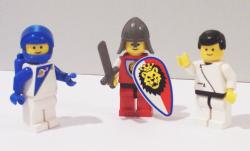 |
|
| Years: |
1974-Present |
| ' | |
Minifigures, commonly referred to as a "minifig", or simply just "fig", are small plastic figures just over 1 1/2 inches (4 cm), or four bricks tall. They connect to LEGO System Bricks, and usually consist of 9-10 parts. The minifigure was designed by LEGO model builder Jens Nygaard Knudsen, along with other early minifigure designs. The modern minifigure was patented with the U.S. Patent office on Dec. 18, 1979, with Knudsen and Godtfred Kirk Christiansen as the inventors.
Design
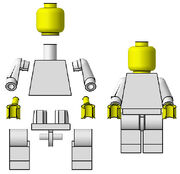
Anatomy of a minifigure
A basic minifigure is composed of several separate essential LEGO pieces: head, torso, arms, hands, hips, and legs. Minifigures typically come packaged as three separate parts in LEGO sets: head, torso/arms/hands, and hips/legs. Each basic minifigure has the same height as four normal stacked bricks. However, some head accessories, such as helmets and mohawks, can make minifigures slightly taller.
Minifigure heads are cylindrical and attach to the peg on top of the torso, which allows the head to rotate. This also allows special items to fit over the torso, such as air tanks, rucksacks, capes or breastplates. The standard heads (LEGO has made other forms of heads for weird aliens and such) also have a stud on top,which is the same size as studs on LEGO bricks, to which things can be attached. Head accessories are varied, including hair, helmets, hats and hoods. These variations allow minifigures to be highly customizable.
Minifigure torsos have a fairly traditional shape, flat across the bottom and narrowing towards the curve of the shoulders. The torso is fitted with a peg on top to allow for the connection of the head and/or other accessories. Torsos are often printed with various details reflecting the design of a character, including blank spaces indicating a slimmer body type as on a female character. Modified torsos also exist, such as ones from the Ninjago theme that are designed to go on top of other torsos to provide additional limbs; these include an overlapping piece on the upper torso and can also include shoulder armor.
A few LEGO arms, such as some of the Minifigures theme, have printings on them. The hands of a minifigure are shaped similarly to a "C", which allows them to hold many LEGO accessories, as well as plates and tiles (by their sides), or on the top of the minifigure's hand. There are hundreds of different accessories, including axes, magic wands, cups, guns, swords, food, documents, etc. The tops of the hands are also roughly the same size as the studs on LEGO bricks, allowing various LEGO pieces to be placed on top of them. LEGO has made extra pieces that fit in the hand socket, like pirate hooks or boxing gloves. Minifigures such as Vampire Bat and Man-Bat have combined wing/arm pieces.
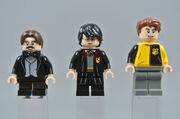
Comparison of Part 41879, Part 970cm00 and Part 970c00
The legs can rotate independently beyond 90 degrees forwards and approaching 45 degrees backwards, making a total rotation of 135 degrees. They also attach to normal LEGO bricks in either a sitting or standing position. There are long legs like those of the Toy Story character Woody, which can still rotate, and short ones like Yoda's or Dobby's, which cannot rotate. These short legs are most commonly used for children in the City theme. There is also legs called "Medium Legs" which are commonly used for teenagers in the Harry Potter theme. LEGO has made a peg leg that can fit in the leg sockets, seen in minifigures such as Captain Brickbeard and Rizzo. Minifigures like Centaur and Cooper have more than two legs and minifigures like Genie and Nadakhan don't have legs.
According to LEGO.com, most minifigures are coloured yellow to display equalization in ethnic society. The use of different tones of colour came about when LEGO decided that minifigures should look "authentic" to the way they were portrayed, this later expanded into licensed themes such as Star Wars to display correct characterization. The yellow coloration is still used in unlicensed themes, such as Ninjago, for purposes of equalization in ethnic society. [1]
History
Original Figures
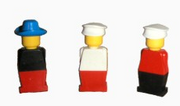
The first minifigures from 1974
The original LEGO figures were released in 1956 in HO scale in a Town Plan system supplemental set, 1271 Traffic Police.
Early Minifigures appearing in 1974 were known as LEGOLAND Minifigures along with their large counterpart Homemaker Figure Maxifigure and followed by the Duplo figure in 1976. The early minifigures were similar in height to modern minifigures, but have one-piece non-movable legs and a one-piece torso. They were blocky and their arms were depicted as being in their pockets. The figure's heads were the same as those of minifigures, but they were blank. Their only range of motion was at the head. They also came with hats or hairpieces. In the LEGO Book, they were modified by the designers of the minifigures continuously, going through various stages with movable arms, circular hands, and textured faces. Eventually, the designers settled upon what is considered a minifigure today.
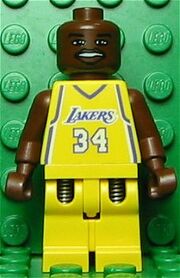
Shaquille O'Neal, an example of a naturally skin-toned minifigure
The first minifigure with movable arms and legs was a policeman released in the year of 1978, with seven different figures in Castle, Space and Town themes. Many Town minifigure torsos had a sticker instead of a printed pattern on one. The Castle minifigures have plain torsos, instead of having a body part with a sticker/symbol on it. The Classic Space minifigures were the first to be printed, but their printing rubbed off easily. Until 1989, minifigures' heads only had a simple facial expression of two black dots for eyes, and a black curved smile. In that year, minifigures in the Pirates theme were produced with different facial expressions. The Pirates minifigures also included hooks for hands, and wooden legs, the first departure from the traditional hands and legs. In 1994, Islanders introduced the first minifigures with leg printings, and reused this feature for Major Kartofski later that year. In mid-2000, Football introduced the first minifigures with back printings, a feature that LEGO would expand in 1349 LEGO Studios Steven Spielberg MovieMaker Set later that year. In 2001, the Harry Potter series’s 4702 The Final Challenge introduced the first minifigure with a double-sided head. In 2002, the first minifigures with short legs were published. In 1997 the release of the Western line of sets saw the introduction of the first minifigures with racial characteristics, with the Indian Minifigures. In 2003, the first Minifigures with natural skin-tones — as opposed to the yellow previously used — were released as part of Basketball; these minifigures also represented specific people. The following year, the use of natural skin tones was expanded to licensed products, such as Indiana Jones, Harry Potter and Star Wars minifigures. As of 2003, LEGO had produced four billion minifigures. There are at least 3655 different minifigures produced between 1975 and 2010 and the number of new minfigures per year is increasing rapidly. In 2010 more than 300 new minifigures were introduced. [1]
Variations
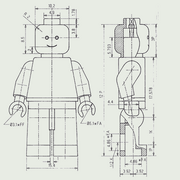
Technical drawing of a Minifigure
While almost all minifigure torsos, arms and legs are the same size and shape, some sets and themes have included figures that differ from this standard. The Alien Pirate and Alien Commander minifigures have a normal trans-green head with no expression, but have a neck piece that resembles the face of the alien, and a hat piece that resembles the brain. The minifigure's head then resembles a specially moulded head. Some minifigures for women, particularly in Castle and Pirate sets, have used large 2x2x2 sloped bricks instead of legs to resemble dresses or skirts (slightly longer than legs). Skeletons, in Pirate and Castle sets, have the standard minifigure head, but have specialized skeletal arms, legs and torso (which are still detachable from each other)-in addition, a new version of skeleton torso was produced with more articulate arms.
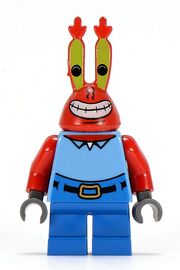
Mr. Krabs, a minifigure with shorter legs than traditional
Shorter legs, without joints at the hip, have been used for children, Yoda and Ewoks in Star Wars sets, Goblins and House Elves, such as Dobby in the Harry Potter sets, Dwarfs, in Castle, SpongeBob and Mr. Krabs in the SpongeBob SquarePants sets, Short Round in the Indiana Jones sets, Stinky Pete and the Aliens in the Toy Story sets, and more. Pirate minifigures have had peg legs (one leg and one peg leg) and Hooks for hands, later used in other themes such as Adventurers, Alien Conquest, Alpha Team, and Legends of Chima. The minifigures Squid Warrior from Atlantis and the Alien Commander have legs that resemble tentacles. Hagrid, from Harry Potter, uses a larger minifigure, with only the head being separable. Lately, some minifigures, such as Woody have also had heads that differ from the traditional cylindrical shape. Traditional accessories, such as hats and helmets, cannot be placed on these different heads. Examples include Stinky Pete, Yoda, Ewoks, Dobby and Goblins as mentioned above. Some minifigures, such as Chewbacca, SpongeBob and Thi-Sen have head pieces that fit like ordinary heads, but end up covering more. In Orient Expedition, a subtheme of Adventurers, there are large figures (Yeti, Tygurah, Jun-Chi, all of which were made of a large pair of legs and a torso). There has also been a taller type of minifigure leg, released in Toy Story, to allow for a height different between Woody and Buzz while allowing Buzz to remain taller than some others. Woody, Jessie and Zurg also had longer arms so they're more to scale with the longer legs.
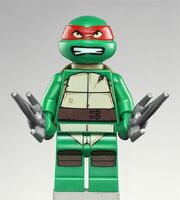
Raphael, a minifigure with a custom head that cannot use hair or a hat
Child-friendly versions of minifigures, which are much more difficult to take apart, have also been designed. Plus, some of the newer figures have special features that can light up (such as lightsabers and flashlights). By pressing down on their heads, their flashlight part (which is also a lightsaber handle and is one piece with the hand and arm) lights up. While this adds a new feature, these minifigures cannot come apart into as many pieces, which could discourage those who wish to customize them. The top of their heads can come off, because inside of that is a battery. However, it is not especially easy to do so and can damage them. Their heads can also come off, but it is not suggested because the heads connect to the body where the electricity travels to the arm.

General Grievous, a minifigure made of special pieces
Minifigures built from special pieces were first introduced in Star Wars. Martians are builds for five pieces: two double arms, mechanical torso, a combined leg piece and a head. This formula is repeated for many Star Wars droids. Battle droids follow the same pattern, while Super Battle Droids have the head fixed to the torso, General Grievous has space for four arms and IG-88 has a head constructed from LEGO elements. Other droids, such as Droidekas, Spider Droids and Pit Droids, are constructed entirely from ordinary LEGO elements many of which were originally made for the droid minifigures, but are none the less often considered minifigures. R2-D2, and other Astromech Droids, are constructed from specialized elements; with a separate top, body and two legs. Recently, the robots of Exo-Force have a design similar to the battle droids, but have separate legs and movable hands, and the head fixed on a small torso. The minifigures C-3PO, Protocol Droid and TC-14 have a special molded head for characters in the Star Wars franchise. There are also Skeletons of a newer kind, who have a similar design to the battle droids. They still have a skeleton torso and legs, but their arms now can move articulately. In addition, in 2007 new Battle Droid arms were released, allowing droids and skeletons to hold their weapons straight up instead of sideways only. There have also been very rare minifigures released, such as a 14K gold C-3PO which only 5 were made, a bronze Boba Fett and a silver TC-14.
Minifigures with special heads
| Name | Theme |
|---|---|
| 4-LOM | Star Wars |
| Acidicus | Ninjago |
| Admiral Ackbar | Star Wars |
| Alien (Mars Mission) | Mars Mission |
| Alien (Minifigures) | Minifigures |
| Alien (Toy Story) | Toy Story |
| Alien Commander (Mars Mission) | Mars Mission |
| Apu Nahasapeemapetilon | The Simpsons |
| Aspheera | Ninjago |
| Awakened Warrior | Ninjago |
| Bart Simpson | The Simpsons |
| Bert (Sesame Street) | Sesame Street |
| Big Bird | Sesame Street
LEGO Ideas |
| Bith | Star Wars |
| Bossk | Star Wars |
| Bugs Bunny | Looney Tunes
Minifigures |
| Buzz Lightyear | Toy Story |
| Bytar | Ninjago |
| C-3PO | Star Wars |
| Captain Tarpals | Star Wars |
| Char | Ninjago |
| Cheshire Cat | Disney
Minifigures |
| Chewbacca | Star Wars |
| Chief Chirpa | Star Wars |
| Chief Wiggum | The Simpsons
Minifigures |
| Chip & Dale | Disney
Minifigures |
| Chokun | Ninjago |
| Chop'rai | Ninjago |
| Clancee | Ninjago |
| Clock King | The LEGO Batman Movie
Minifigures |
| Clockwork Robot | Minifigures |
| Coleman Trebor | Star Wars |
| Cookie Monster | Sesame Street
LEGO Ideas |
| Cyclops (Minifigures) | Minifigures |
| Daffy Duck | Looney Tunes
Minifigures |
| Daisy Duck | Disney
Minifigures |
| Dobby | Harry Potter |
| Donatello | Teenage Mutant Ninja Turtles |
| Donald Duck | Disney |
| Elmo | Sesame Street
LEGO Ideas |
| Ernie | Sesame Street
LEGO Ideas |
| Ewok Warrior | Star Wars |
| Fangdam | Ninjago |
| Fangtom | Ninjago |
| Gamorrean Guard | Star Wars |
| Geonosian Pilot | Star Wars |
| Geonosian Warrior | Star Wars |
| Geonosian Zombie | Star Wars |
| Gingerbread Man | Minifigures |
| Glutinous | Ninjago |
| Goblin (Harry Potter) | Harry Potter |
| Goofy | Disney |
| Greedo | Star Wars |
| Griphook | Harry Potter |
| Grogu | Star Wars |
| Gungan Warrior | Star Wars |
| Hausner | Ninjago |
| Hazza D'ur | Ninjago |
| Homer Simpson | The Simpsons |
| Ithorian Jedi Master | Star Wars |
| Jar Jar Binks | Star Wars |
| Jessie | Toy Story |
| Kalmaar | Ninjago |
| Kapau'rai | Ninjago |
| K-3PO | Star Wars |
| Kit Fisto | Star Wars |
| Kruncha | Ninjago |
| Lisa Simpson | The Simpsons |
| Lizaru | Ninjago |
| Logray | Star Wars |
| Lola Bunny | Looney Tunes
Minifigures |
| Maaray Guard | Ninjago |
| Maggie Simpson | The Simpsons |
| Marge Simpson | The Simpsons |
| Max Rebo | Star Wars |
| Maz Kanata | Star Wars |
| Mezmo | Ninjago |
| Michelangelo | Teenage Mutant Ninja Turtles |
| Mickey Mouse | Disney |
| Milhouse Van Houten | The Simpsons |
| Minnie Mouse | Disney |
| Minotaur (Minifigures) | Minifigures |
| Mon Calamari Officer | Star Wars |
| Montgomery Burns | The Simpsons |
| Mr. Krabs | SpongeBob SquarePants |
| Nahdar Vebb | Star Wars |
| Nuckal | Ninjago |
| Onaconda Farr | Star Wars |
| Paploo | Star Wars |
| Patrick | SpongeBob SquarePants |
| Patty Bouvier | The Simpsons
Minifigures |
| Petunia Pig | Looney Tunes
Minifigures |
| Piglet | Disney
LEGO Ideas |
| Plo Koon | Star Wars |
| Poggle the Lesser | Star Wars |
| Pong Krell | Star Wars |
| Porky Pig | Looney Tunes
Minifigures |
| Principal Skinner | The Simpsons
Minifigures |
| Protocol Droid | Star Wars |
| Pyro Destroyer | Ninjago |
| Pyro Slayer | Ninjago |
| Pyro Whipper | Ninjago |
| Pythor P. Chumsworth | Ninjago |
| R-3PO | Star Wars |
| RA-7 Protocol Droid | Star Wars |
| Ralph Wiggum | The Simpsons
Minifigures |
| Rabbit (Winnie the Pooh) | Disney
LEGO Ideas |
| Raphael | Teenage Mutant Ninja Turtles |
| Ree-Yees | Star Wars |
| Remus Lupin | Harry Potter |
| Richie | Ninjago |
| Road Runner | Looney Tunes
Minifigures |
| Samukai | Ninjago |
| Sandy Cheeks | SpongeBob Squarepants |
| Scrooge McDuck | Disney |
| Selma Bouvier | The Simpsons
Minifigures |
| Selma | Ninjago |
| Shark Warrior | Atlantis |
| Skales | Ninjago |
| Skalidor | Ninjago |
| Slithraa | Ninjago |
| Snake Villain | Ninjago |
| Speedy Gonzales | Looney Tunes
Minifigures |
| Spitta | Ninjago |
| SpongeBob SquarePants | SpongeBob SquarePants |
| Stitch | Disney
Minifigures |
| Stinky Pete | Toy Story |
| Sylvester | Looney Tunes
Minifigures |
| TC-4 | Star Wars |
| TC-14 | Star Wars |
| Tarfful | Star Wars |
| Tasmanian Devil | Looney Tunes
Minifigures |
| Teebo | Star Wars |
| Teedo | Star Wars |
| Thi-Sen | Star Wars |
| Tigger | Disney
LEGO Ideas |
| Tokkat | Star Wars |
| Tusken Raider | Star Wars |
| Tweety | Looney Tunes
Minifigures |
| TX-20 | Star Wars |
| Wald | Star Wars |
| Watto | Star Wars |
| Werewolf (Minifigures) | Minifigures |
| Werewolf (Studios) | Studios |
| Wicket W. Warrick | Star Wars |
| Wile E. Coyote | Looney Tunes
Minifigures |
| Winnie the Pooh | Disney
LEGO Ideas |
| Woody | Toy Story |
| Wullffwarro | Star Wars |
| Wyplash | Ninjago |
| Yeti (Minifigures) | Minifigures |
| Yoda | Star Wars |
| Zeb Orrelios | Star Wars |
LEGO Storylines
LEGO has made several "systems", where there are particular sets that have a central theme or story. Some examples include the Orient Expedition, Star Wars, Alpha Team, Knights' Kingdom and Knights' Kingdom II. Some of the minifigures from these sets are from popular films or series such as Star Wars, Batman, Indiana Jones, Harry Potter, The Lord of the Rings, The Hobbit, Pirates of the Caribbean, and Prince of Persia. Also, LEGO has some spinoffs or spoofs of popular series, such as Adventurers. Alpha Team was a theme where minifigures in the team fight against Ogel. In 2004 the LEGO Group established sets that included minifigures based on real actors would have their skin tone would change accordingly. Hence the flesh toned minifigures seen in recent Star Wars sets. The Exo-Force storyline features minifigures with colorful anime hair and eyes. The hair was also rubbery. LEGO's older themes also had some storyline aspects, although they were rarer and became much more common later on, when LEGO books and magazines were more common (mid-to-late 1990s). Today, TV series such as Ninjago: Masters of Spinjitzu and Legends of Chima: The Animated Series and short films such as The Yoda Chronicles are often released, explaining the themes throughout episodes.
Other LEGO Figures
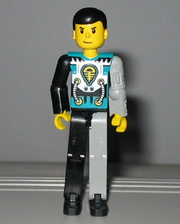
The differently-designed TECHNIC figures
In some lines of products, LEGO has used figures other than the standard minifigures. TECHNIC has used larger TECHNIC Figures from 1986 to 1999. These figures are more realistic, although still angular, and have more degrees of motion, such as at the knees and elbows. However, they cannot be easily disassembled; even hair is non-removable. Some included helmets.
The Fabuland line of the 1980s consisted of larger anthropomorphic animal characters, which also could not be easily disassembled. All parts of Basic figures inspired by DUPLO Figure and Fabuland Figure were also firmly fixed together. The two variants of this figure were used in 3+ building sets between 1981 and 1991.
Belville and Scala, LEGO lines aimed at girls, also have larger figures. They are similar to TECHNIC figures in range of motion, but have less angular legs, arms and torsos. Scala figures more closely resemble Dolls, in that clothes are separate from the figures and the hair is composed of strands and not moulded plastic.
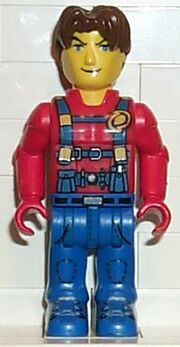
A 4+ figure
More recently, LEGO introduced BIONICLE figures, such as Toa, which are larger than normal minifigures. They are also composed of separate pieces, unlike other large LEGO figures. In 2005, LEGO released BIONICLE playsets for the first time, with minifigures of characters that previously only had large figures (Toa and Visorak/Piraka). While these minifigures did not have movable parts, in 2006, LEGO released Toa Inika playsets containing minifigures with movable parts, similar to the Robots from Exo-Force. They followed this with the release of playsets containing the Toa Mahri in 2006, which were largely similar except for the addition of a new specially-moulded arm element.
Another type of LEGO figure is found in the Jack Stone sets, called 4+ Figures. They have carved faces, but are bigger, and do not have interchangeable parts. Similar large figures were also found in other themes, such as the 4+ Spider-Man and Creator sets.
Another different minifigure is the Skeleton. They are made up of several different pieces, only one of them (the head) used in regular minifigures.
In the LEGO board games, LEGO has made Microfigures that are easier to move around a gameboard than average minifigures. They are smaller, made of one piece and do not have separate arms or legs as said above. They also do not feature any poseable components.
In 2012, LEGO made the Mini-doll figure, which is more realistic and 3 millimetres taller than a regular minifigure (with no hairpiece). So far, over fifty mini-dolls have been produced. Initially, they were exclusive to the Friends line, but in 2014, they were adapted to a new wave of Disney Princess theme sets and in 2015 they were featured in the Elves theme.
In 2014, LEGO introduced the Mini robot in Hero Factory sets.
Types
- See Category:Minifigures.
Gallery
See Also
- Basic figure
- DUPLO Figure
- Fabuland Figure
- LEGOLAND Minifigure
- Microfigure
- QUATRO Figure
- TECHNIC Figure
- Belville Figure
- Homemaker Figure
- Micro Mob
- Big Figure
External Links
References
- ↑ Bartneck, C. (2011). The Unofficial LEGO Minifigure Catalog. Charleston: CreateSpace. ISBN 978-1-4635-1897-4
Resources
| view · talk · edit LEGO Figures | ||||
|---|---|---|---|---|
| System Scale | Minifigure | LEGOLAND Minifigure | Mini-doll figure | Animal | Big Figs | Brick-built figure | 4+ Figure | |||
| DUPLO Scale | DUPLO Figure | Fabuland Figure | QUATRO Figure | |||
| Doll Scale | Belville Figure | Galidor | Homemaker Figure (Maxifigure) | Scala Figure | TECHNIC Figure | |||
| Other Scale | Basic figure | Microfigure | Micro Mob | Nanofigure | Town Plan HO Scale figure | |||


